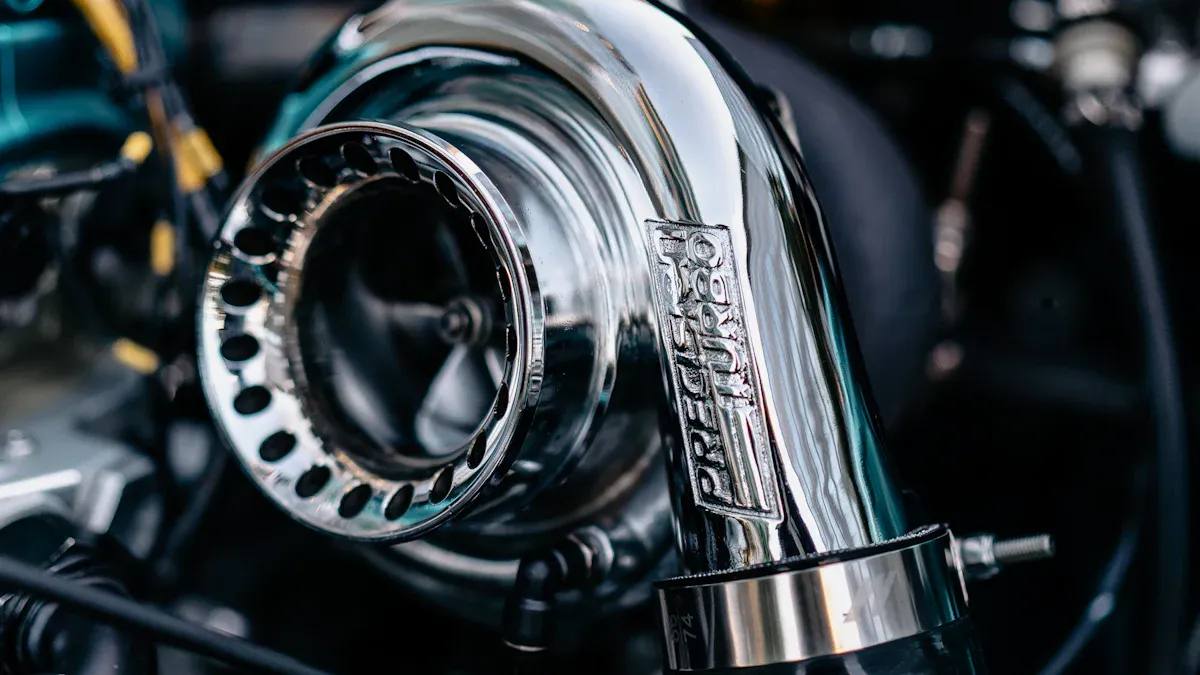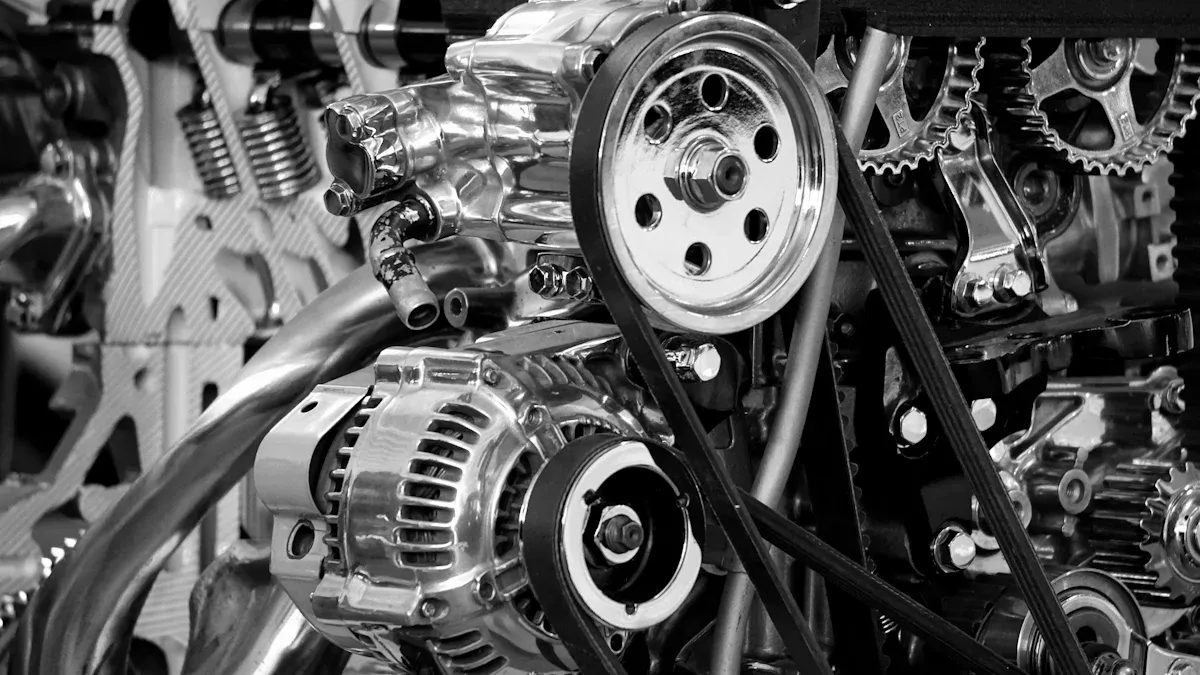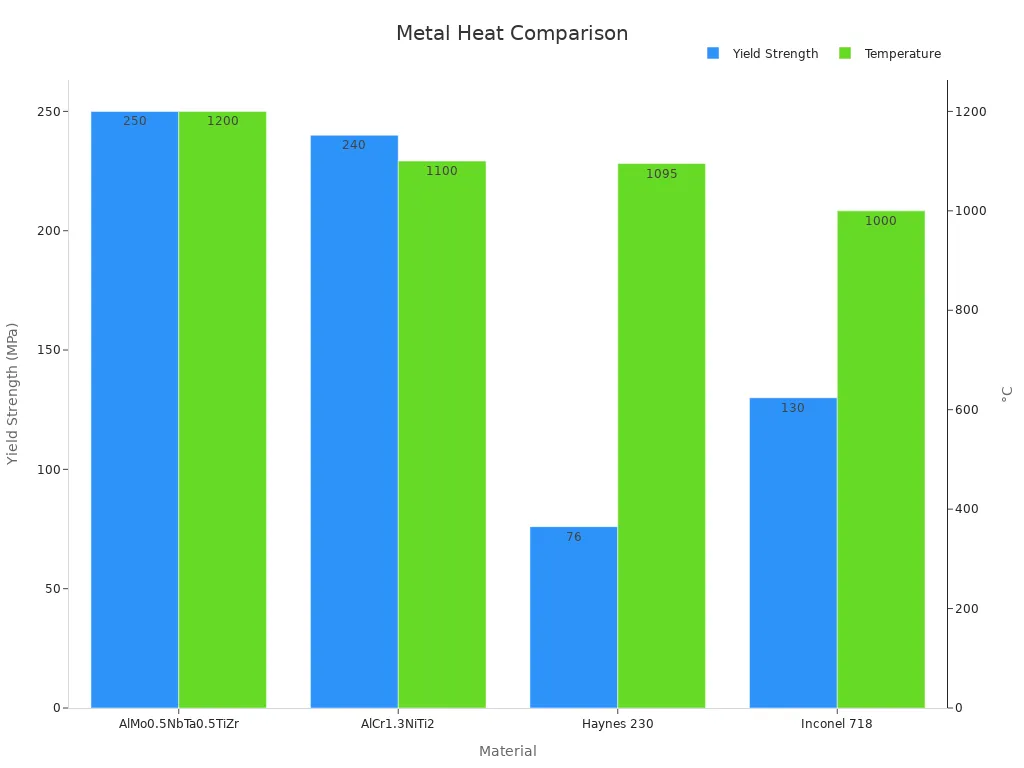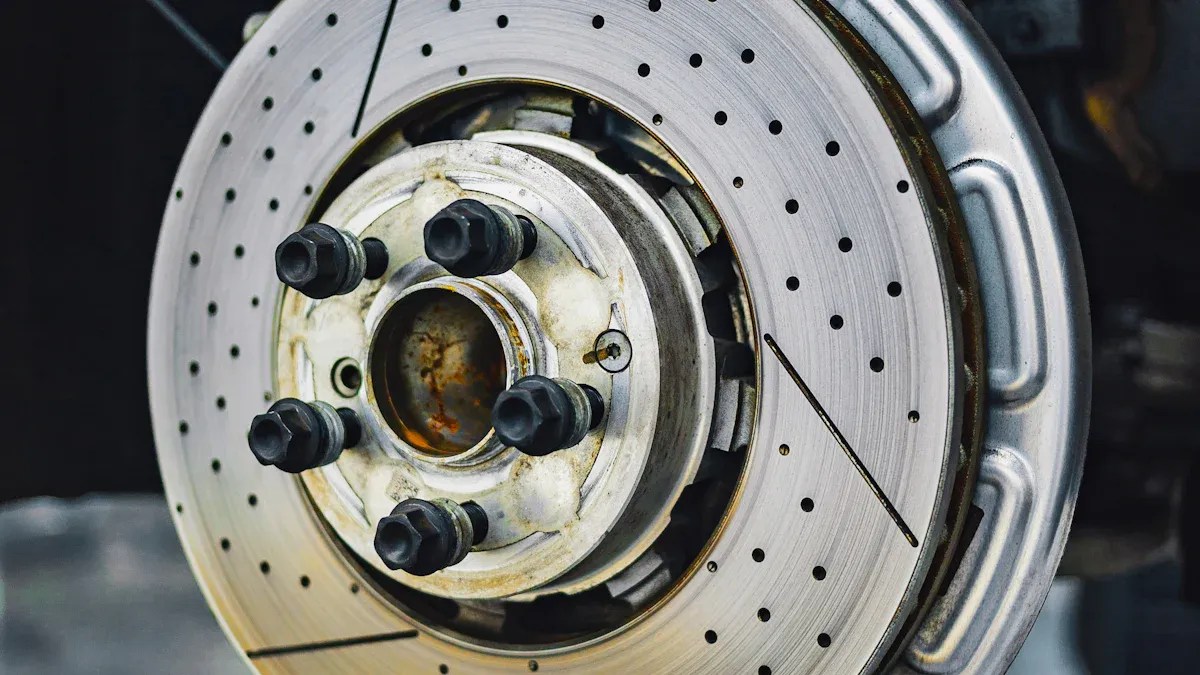
Heat plays a critical role in the performance and safety of modern vehicles. Without proper management, it can damage essential components. For example:
Heat-resistant materials help combat these challenges. They protect automotive parts from extreme temperatures and ensure effective engine bay heat management, especially in high-performance and electric vehicles.
The engine bay is one of the hottest areas in a car. Temperatures can soar due to combustion, friction, and the operation of various components. Without proper heat management, these high temperatures can damage nearby parts. For instance, rubber hoses may crack, and electrical wires can melt. You might notice reduced performance or even engine failure if these issues go unchecked.
Modern vehicles, especially those with advanced driver-assistance systems (ADAS), face additional challenges. The growing number of sensors in ADAS increases data processing needs, which generates more heat. In hot climates, parked cars can experience extreme temperature spikes, further complicating heat management. Designers must address these challenges to ensure your car remains reliable and efficient.
Thermal stress occurs when materials expand and contract due to temperature changes. Over time, this can weaken components and lead to failure. Research shows that stress concentrations in materials, such as laminated composite plates, can significantly increase at defect points. For example, the stress at the tip of a spherical cavity can be over twice the normal level. This highlights the importance of using high-quality, heat-resistant materials to reduce the risk of failure.
You can think of thermal stress as a silent enemy. It doesn’t cause immediate damage but gradually wears down parts. Proper heat management helps minimize this stress, ensuring your vehicle’s components last longer.
Electric vehicles (EVs) present unique heat management challenges compared to traditional cars. Their batteries, motors, and power electronics generate significant heat during operation. If not managed properly, this heat can reduce efficiency and shorten the lifespan of these components.
| Aspect of Thermal Management | Description |
|---|---|
| Battery Thermal Management | Maintains optimal battery temperatures for performance and longevity. |
| Motor Thermal Management | Prevents overheating of electric motors through cooling systems. |
| Power Electronics Management | Ensures efficiency and reliability by managing heat in power electronics. |
| Impact on Range | Highlights how temperature affects the driving range of EVs. |
For EVs, effective heat management is essential. It not only protects critical components but also ensures you get the best performance and range from your vehicle.

Modern vehicles rely on heat-resistant materials to ensure safety and performance in extreme conditions. These materials play a vital role in protecting components within the engine compartment and other high-temperature areas. Let’s explore the key types of heat-resistant materials used in automotive applications.
Metals and alloys are the backbone of heat-resistant materials in vehicles. They provide exceptional strength and durability under extreme heat. For example, alloys like Inconel and Haynes 230 are commonly used in high-performance engines due to their ability to withstand temperatures exceeding 1,000°C. These materials maintain their structural integrity even in the harshest conditions, making them ideal for engine components and exhaust systems.
Here’s a comparison of some high-temperature alloys:
| Material | Yield Strength (MPa) | Specific Yield Strength (MPa·cm³·g⁻¹) | Temperature (°C) |
|---|---|---|---|
| AlMo0.5NbTa0.5TiZr | 250 | 35 | 1200 |
| AlCr1.3NiTi2 | 240 | 37.3 | 1100 |
| Haynes 230 | 76 | 8.5 | 1095 |
| Inconel 718 | 130 | 15.82 | 1000 |

These metals and alloys not only resist heat but also reduce thermal stress, ensuring the longevity of critical components.
Advanced ceramics and composites are revolutionizing heat management in automotive applications. These materials excel in high-temperature environments, offering superior thermal resistance and mechanical strength. Ceramic matrix composites (CMCs), for instance, can withstand temperatures ranging from 1,000°C to 1,800°C.
Key benefits of CMCs include:
- Maintaining mechanical strength under extreme heat.
- Reducing risks of creep and thermal expansion.
- Customizability for specific applications, enhancing their effectiveness.
You’ll often find these materials in components like turbochargers and exhaust systems, where high heat and thermal stress are constant challenges. Their ability to handle such conditions makes them indispensable in modern automotive design.
High-performance polymers and resins are lightweight yet durable materials that thrive in high-temperature environments. These materials are extensively used in engine components, where they resist heat and reduce weight. By lowering the overall weight of a vehicle, they contribute to improved fuel efficiency and performance.
Some notable features of high-performance polymers include:
- Exceptional resistance to heat and thermal degradation.
- Applications in both the automotive and aerospace industries.
- Compatibility with high-temperature adhesives for enhanced durability.
For example, these polymers are often paired with high-temperature adhesives to create robust seals and joints in the engine compartment. This combination ensures that components remain secure and functional even under intense heat.
Insulating coatings and heat shields play a vital role in protecting your car's components from extreme temperatures. These materials act as a thermal barrier, reducing the transfer of heat to sensitive parts. By doing so, they ensure your vehicle operates efficiently and safely, even under demanding conditions.
Heat shields are designed to reflect and dissipate heat away from critical areas. For example, they protect engine components, which enhances performance and reliability. They also improve passenger comfort by blocking engine and exhaust heat from entering the cabin. In electric vehicles, heat shields insulate battery packs, maintaining an optimal temperature for performance and safety. Effective heat management extends the lifespan of these components, reducing maintenance costs over time.
Insulating coatings complement heat shields by providing an additional layer of protection. These coatings are applied directly to surfaces, forming a self-adhesive heat shield that resists high temperatures. You’ll often find them under the bonnet as an under bonnet heat barrier, where they shield the engine bay from excessive heat. This combination of coatings and shields ensures that your car remains durable and efficient, even in extreme environments.
The use of self-adhesive heat shields has become increasingly popular due to their versatility. These shields are easy to install and can be customized to fit various components. They are commonly used in areas like the exhaust system, where temperatures can reach extreme levels. By acting as a thermal barrier, they prevent heat from damaging nearby parts, ensuring your car remains reliable.
In addition to protecting components, insulating coatings and heat shields contribute to overall vehicle performance. By managing heat effectively, they reduce the risk of overheating and thermal stress. This not only improves the safety of your car but also enhances its efficiency. Whether you drive a traditional car or an electric vehicle, these materials are essential for maintaining optimal performance.
Heat-resistant materials play a crucial role in improving your vehicle's engine performance. By managing heat effectively, these materials ensure that the engine operates at optimal temperatures. For example, high-performance alloys like Inconel maintain their strength even at extreme temperatures, allowing the engine to function efficiently without overheating. This is especially important in performance vehicles, where engines generate significant heat during operation.
Proper heat management also prevents fuel from vaporizing prematurely, which can lead to vapor lock and reduced combustion efficiency. Cooler fuel burns more effectively, delivering better power output and fuel economy. Heat-resistant materials, such as insulating coatings and heat shields, act as a thermal barrier, keeping the engine bay cooler and enhancing overall efficiency.
In electric vehicles, these materials protect motors and power electronics from overheating. By maintaining stable temperatures, they ensure that your EV delivers consistent performance and extends its driving range. Whether you drive a traditional car or an EV, heat-resistant materials are essential for maximizing engine efficiency.
Safety is a top priority in automotive design, and heat-resistant materials provide critical protection for your vehicle's components. High temperatures can cause materials to degrade, leading to failures that compromise safety. For instance, rubber hoses may crack, and electrical wires can melt under extreme heat. By using heat-resistant materials, manufacturers ensure that these components remain reliable even in harsh conditions.
Thermal barriers, such as heat shields, protect sensitive parts from excessive heat exposure. This reduces the risk of fires and other safety hazards. In addition, advanced ceramics and composites resist thermal stress, preventing cracks and fractures in critical components like turbochargers and exhaust systems. These materials not only enhance safety but also improve the reliability of your vehicle.
Heat-resistant materials also play a vital role in protecting EV batteries. By maintaining optimal temperatures, they prevent overheating, which can lead to thermal runaway—a dangerous condition where the battery overheats uncontrollably. This added layer of safety gives you peace of mind while driving.
Vehicles often operate in challenging environments, from scorching deserts to freezing winters. Heat-resistant materials ensure that your car's components withstand these extremes, providing long-lasting durability. For example, nickel-based superalloys used in aerospace applications demonstrate exceptional resistance to heat and stress. These materials maintain their mechanical properties under extreme conditions, making them ideal for automotive use.
Heat aging tests reveal how materials perform over time when exposed to high temperatures. Results show that heat-resistant plastics and composites retain their strength and flexibility, even after prolonged exposure. This durability reduces the need for frequent replacements, saving you money on maintenance.
Key factors affecting material longevity include:
1. Thermal Fatigue: Repeated temperature cycling weakens materials over time.
2. Thermal Expansion and Contraction: Different rates of expansion and contraction create stress, leading to cracks.
3. Degradation: Prolonged heat exposure can make materials brittle or reduce their strength.
By selecting the right heat-resistant materials, manufacturers ensure that your vehicle performs reliably for years, even in the harshest conditions. These materials not only extend the lifespan of components but also contribute to the overall durability of your car.
Heat-resistant materials play a vital role in making vehicles lighter without compromising performance. Lightweight automotive design has become a priority for manufacturers, as it directly impacts fuel efficiency, emissions, and overall sustainability. By replacing heavier components with advanced materials, you can enjoy a more efficient and eco-friendly driving experience.
One of the key advantages of heat-resistant materials is their ability to withstand extreme conditions while reducing weight. For example:
- High-temperature thermoplastics and composites often replace heavier metal parts in vehicles. These materials provide the necessary thermal stability and mechanical strength for high-performance applications.
- Advanced materials resist oxidation and corrosion, ensuring durability even in harsh environments. This durability allows manufacturers to use thinner, lighter components without sacrificing reliability.
Did you know? Lightweight materials not only improve fuel efficiency but also enhance handling and acceleration. A lighter car requires less energy to move, which means better performance and lower emissions.
The automotive heat insulation materials market has also shifted its focus toward lightweighting. Manufacturers now prioritize materials that maintain excellent thermal performance while reducing overall vehicle weight. This approach supports sustainability goals by lowering fuel consumption and greenhouse gas emissions.
| Material Type | Key Benefit | Application |
|---|---|---|
| High-temperature thermoplastics | Lightweight and thermally stable | Engine components, under-hood parts |
| Composites | Strong and resistant to thermal stress | Turbochargers, exhaust systems |
| Insulating coatings | Thin yet effective thermal barriers | Heat shields, battery packs |
By incorporating these materials into your car, manufacturers achieve a balance between weight reduction and performance. For instance, high-temperature composites are commonly used in turbochargers and exhaust systems. These components face intense heat and stress, yet the lightweight materials ensure they remain durable and efficient.
In electric vehicles, lightweight heat-resistant materials are even more critical. They help reduce the overall weight of the battery pack and other components, which directly improves the driving range. A lighter EV requires less energy to operate, allowing you to travel farther on a single charge.
When you think about the future of automotive design, lightweight heat-resistant materials will continue to lead the way. They not only make vehicles more efficient but also contribute to a cleaner, greener planet. By choosing cars built with these advanced materials, you support innovation and sustainability in the automotive industry.

Heat-resistant materials are essential for engine components and turbochargers. These parts operate under extreme temperatures, often exceeding 1,000°C. Materials like polyetherimide (PEI) and polyphenylsulfone (PPSU) are commonly used in under-the-hood components due to their excellent heat resistance. Turbochargers, which compress air to boost engine performance, rely on materials like alumina ceramic substrates. These substrates can withstand over 1,000°C, reducing fuel consumption in diesel engines by more than 30%.
Turbo blankets, made from advanced composites, play a critical role in managing heat. They insulate the turbocharger, preventing heat from escaping into the engine bay. This improves efficiency and protects nearby components. By using these materials, manufacturers ensure that your engine performs reliably, even under intense conditions.
Exhaust systems and catalytic converters face constant exposure to high temperatures. Heat-resistant materials like high-grade stainless steel alloys (304 and 316) provide exceptional thermal stability and corrosion resistance. These alloys are ideal for exhaust systems, which must handle extreme heat and harsh environments.
Exhaust wraps and heat shields are also vital. Exhaust wraps reduce heat transfer, keeping the exhaust system cooler and improving performance. Heat shields protect sensitive components from exhaust heat, enhancing safety and reliability. Catalytic converters, which reduce harmful emissions, depend on temperature stability to function efficiently. Innovative designs in heat-resistant materials improve their performance while addressing cost and durability challenges.
Electric vehicle (EV) batteries generate significant heat during operation. Effective thermal management is crucial to maintain performance and safety. Advanced materials like integrated self-heating battery (iSHB) structures offer superior thermal performance. These structures reduce system volume by 68% compared to traditional configurations while retaining 98% of their energy capacity.
Direct thermal contact between battery materials and heat shields improves cooling efficiency. This reduces thermal resistance by up to ten times compared to conventional methods. Turbo blankets and insulating coatings further enhance heat management, ensuring that EV batteries operate within optimal temperature ranges. These advancements extend battery life and improve driving range, making EVs more efficient and reliable.
Sensitive electronics in your car, such as sensors, control modules, and infotainment systems, require protection from extreme heat. Without proper shielding, these components can overheat, leading to malfunctions or permanent damage. Heat shields play a crucial role in maintaining their performance and reliability.
A heat shield acts as a thermal barrier, deflecting heat away from delicate electronic parts. For example, under-the-hood electronics often face high temperatures from the engine and exhaust system. By installing a heat shield, you can prevent heat from reaching these components, ensuring they operate within safe temperature ranges. This protection is especially important in modern vehicles, where advanced electronics control critical functions like braking and navigation.
In some cases, an exhaust heat shield is used to protect electronics located near the exhaust system. These shields are designed to withstand extreme temperatures while minimizing heat transfer. They not only safeguard electronics but also improve overall vehicle safety by reducing the risk of overheating.
Heat shields come in various forms, including rigid panels and flexible wraps. Some are made from lightweight materials like aluminum or composites, which provide excellent thermal resistance without adding unnecessary weight. You can also find self-adhesive heat shields, which are easy to install and customize for specific applications.
By using heat shields, you extend the lifespan of your car's electronics and reduce the likelihood of costly repairs. Whether you drive a traditional car or an electric vehicle, these shields are essential for protecting sensitive components from heat-related damage.
Regular inspections are essential for keeping heat-resistant components in good condition. By checking these parts frequently, you can identify potential problems before they become serious. Early detection helps you avoid costly repairs and reduces downtime. For example, inspecting the engine and exhaust system ensures that minor issues, like cracks or wear, are addressed promptly. This keeps your engine running efficiently and improves fuel consumption.
Inspections also enhance safety. Heat-exposed parts, such as an exhaust heat shield, protect critical components from extreme temperatures. If these parts fail, the risk of damage or accidents increases. Regular maintenance ensures that these shields and other thermal barriers remain effective. By prioritizing inspections, you extend the lifespan of your vehicle and maintain its performance.
Heat-resistant materials face constant exposure to high temperatures, which can cause wear over time. You should look for signs of degradation, such as discoloration, cracks, or warping. These issues often indicate that a component is no longer performing as it should. For instance, an exhaust wrap may lose its insulating properties if it becomes brittle or frayed.
Thermal stress can also weaken materials, especially in areas like the engine bay or exhaust system. Pay attention to any unusual noises, reduced performance, or visible damage. Identifying these signs early allows you to replace or repair parts before they fail completely. This proactive approach ensures your vehicle remains safe and reliable.
To maximize the lifespan of heat-resistant components, follow a few best practices. First, use high-quality materials designed for your vehicle’s specific needs. For example, advanced ceramics or high-performance polymers are excellent choices for thermal resistance. Second, ensure proper installation of parts like heat shields and exhaust wraps. Incorrect installation can reduce their effectiveness and lead to premature wear.
Keep your engine and exhaust system clean. Dirt and debris can trap heat, increasing stress on components. Regular cleaning prevents this buildup and helps maintain optimal performance. Finally, avoid exposing your vehicle to extreme conditions whenever possible. Prolonged exposure to high heat or harsh environments accelerates wear and shortens the lifespan of materials.
By following these steps, you can protect your vehicle’s heat-resistant components and enjoy better performance and durability.
Heat-resistant materials are essential for modern automotive design. They ensure safety, durability, and effective heat management in critical areas like the engine bay and EV batteries. These materials also support innovations in electric and autonomous vehicles, where advanced heat management solutions enhance performance and safety.
Future developments in these materials will continue to shape the automotive industry's efficiency and sustainability.
Heat-resistant materials are specialized substances that withstand high temperatures without degrading. They protect critical components like engines, exhaust systems, and EV batteries. These materials ensure your vehicle operates safely and efficiently under extreme conditions.
Heat shields act as thermal barriers, deflecting heat away from sensitive parts. They protect components like electronics and exhaust systems from overheating. This improves safety, enhances performance, and extends the lifespan of your car.
In electric vehicles, these materials manage battery and motor temperatures. They prevent overheating, ensuring optimal performance and extending driving range. Proper thermal management also enhances battery safety and longevity.
Yes, advanced lightweight materials like composites and high-performance polymers resist extreme heat. They reduce vehicle weight while maintaining durability and thermal stability. This improves fuel efficiency and performance.
Inspect these components regularly, especially in high-temperature areas like the engine bay. Look for signs of wear, such as cracks or discoloration. Early detection helps prevent failures and ensures your vehicle remains reliable.